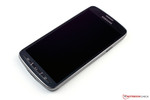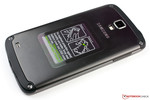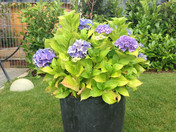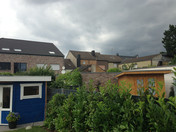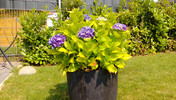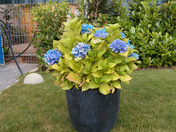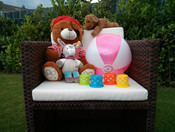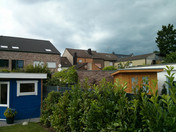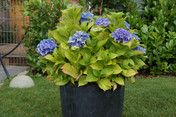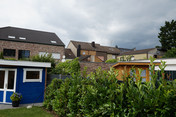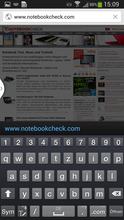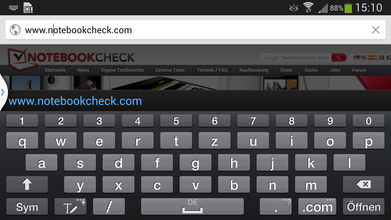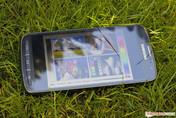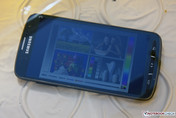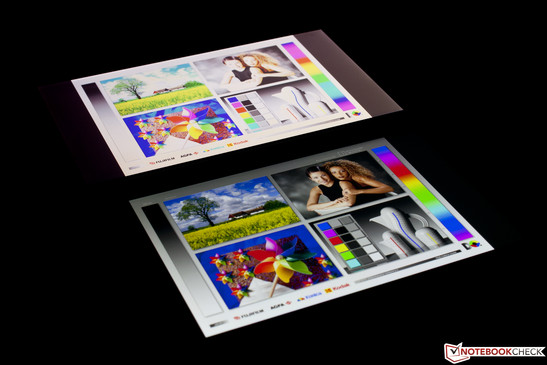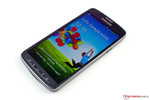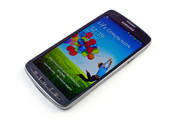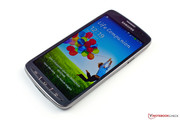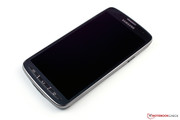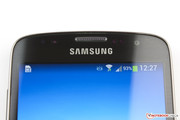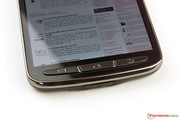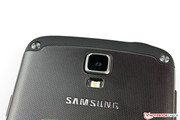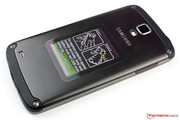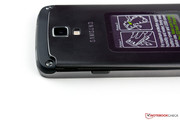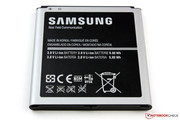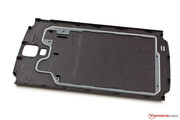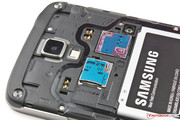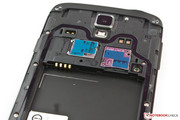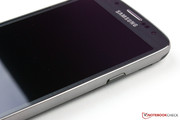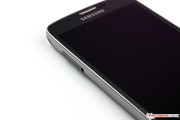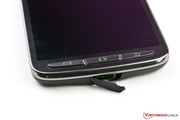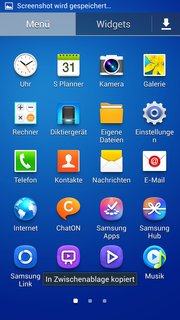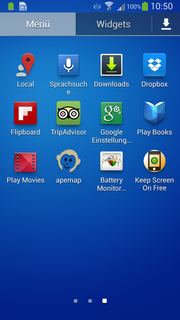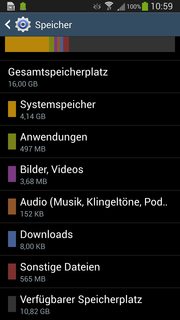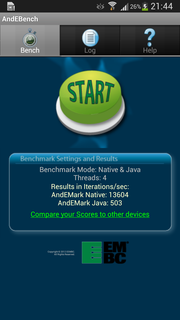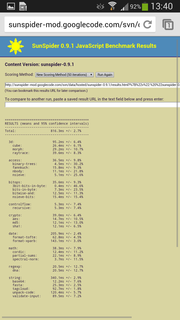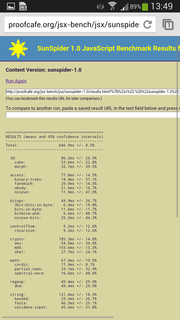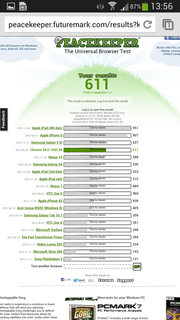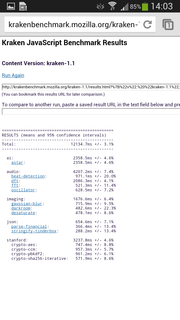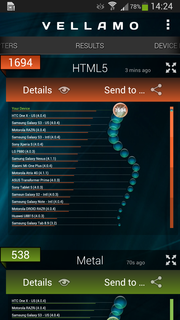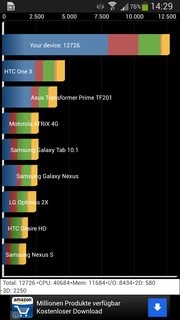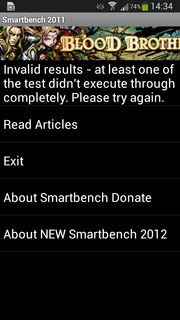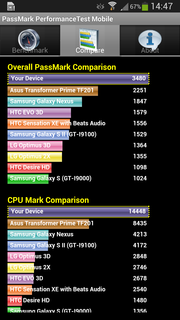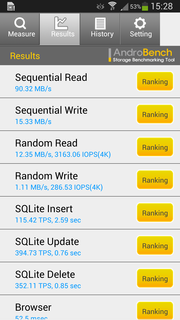Review Samsung Galaxy S4 Active GT-I9295 Smartphone

For the original German review, see here.
Just this past April, Samsung’s most recent outdoor smartphone, the Galaxy Xcover 2, came under our scrutiny. Now the S4 family also has an outdoor member, and unlike the Xcover 2, this is no mid-class device. Instead it closely resembles the Samsung flagship at least when it comes to its inner workings. The Korean company only altered the case, cameras and display. In contrast to the Xcover 2, whose performance muscles are a little underdeveloped, the S4 Active boasts of a Snapdragon 600 processor. The 5-inch Full HD panel rounds off the smartphone’s upper class profile.
With such extravagant equipment, the Sony Xperia Z suddenly has competition. The upper class phone’s outdoor compatibility was a unique selling point. How the Active does in comparison to its Japanese counterpart is a question for our review to answer.
Case
At 139.7 x 71.3 x 9.1 millimeters (~5.5 x 2.81 x 0.36 inches) and 151 grams (~0.33 pounds), the Samsung Galaxy S4 Active is somewhat larger and heavier than the GT-I9505 (137 x 70 x 7.9 mm; 130 g, ~5.39 x 2.76 x 0.31 inches; ~0.29 lbs). The metal frame that encases the device bears most of the responsibility for the heavier weight. It also makes the smartphone seem especially high quality. The S4 Active also proves to be very resistant to twisting and hardly makes any crackling sounds when pressure is applied. It appears not only more solid, but also more refined than the S4. The battery lid is made of plastic, and the device only has black rubber around the top and bottom. The device is available in three colors: urban gray, dive blue and orange flare.
The display is protected by Corning Gorilla Glass 2. Three physical keys are located below the touchscreen. The Sony Xperia Z has no such input options. Since a touchscreen doesn’t work when the panel is wet, the S4 Active still gives the user access to some basic functions in watery circumstances. Samsung also goes above and beyond in terms of the IP certification and certifies their device according to the IP67 standard. That means the device should be dustproof and waterproof in case of short submersion. Sony’s smartphone, however, is only certified according to the IP55 and IP57 standards. That is to say, the device isn’t entirely dustproof, rather, “Ingress of dust is not entirely prevented, but … must not enter in sufficient quantity to interfere with the satisfactory operation of the equipment” (Wikipedia). The Sony device fulfills the same specification against submersion and also offers protection against water jets from any direction.
In real life, the Galaxy S4 Active proves to be well protected. We dunked the device both in a glass of water and in a pond (see video). The smartphone took both in its stride. Unfortunately, the 3.5 mm jack can’t be plugged up, and water collected under the back cover around the camera and speaker. If you get the device wet, it’s a good idea to open the back cover and dry it well. Also, Samsung’s advertisement in which the S4 Active is in use in the ocean is misleading. The user manual advises you not to use the smartphone in saltwater. It’s unclear as to whether that would invalidate the warranty.
Connectivity
The phone’s connectivity options are identical to its brother’s, the GT-I9505. Here you’ll find almost everything your heart could desire. Even the newest WLAN standard ac is supported. Mid-class outdoor devices, like the Xcover 2, definitely can’t keep up here. Sony's flagship lags behind here as well -- the Japanese company doesn’t offer features like Air View, WLAN ac or a high-sensitivity display.
The S4 Active has 16 GB of storage -- 11.2 GB remains available after the first start up. Anyone who doesn’t consider that enough can expand the storage space by up to 64 GB via the micro SD card slot. The multi-function connection on the bottom of the smartphone serves to load the battery, transfer data over micro USB and display images externally via an MHL adapter (available for purchase).
Software
Out of the factory, the Samsung Galaxy S4 Active comes with the up-to-date Android 4.2.2. Samsung superimposes their obligatory TouchWiz interface over the Google operating system, leaving the interface feeling clean and well-engineered. In terms of its operating interface, the device feels like a clone of the Galaxy S4.
Communication & GPS
In this discipline, the S4 Active outclasses the Sony Xperia Z. The WLAN module supports the IEEE-802.11 standards a/b/g/n/ac and transmits in the frequency ranges of 2.4 and 5.0 GHz. The reception range is excellent. Even 40 meters from the router we could still load webpages without a problem. The Xperia Z, however, can only handle the 2.4 GHz standards b/g/n.
In terms of mobile communication standards, the Samsung smartphone supports GRPS (850, 900, 1800, 1900 MHz), HSPA+ (850, 900, 1900, 2100 MHz) and LTE (800, 850, 900, 1800, 2100, 2600 MHz). Especially in the case of the LTE modem, the supported frequency ranges are much broader than those covered by the Active’s competitors from Japan. Additionally, the device offers Bluetooth and NFC.
Our review device has both a GPS and a GLONASS receiver at its command. Even indoors, the phone positions us with the help of navigation satellites very well. The connection is established within less than 30 seconds. Outdoors, the device finds its position much more quickly and accurately.
Telephone Function and Voice Quality
The telephone app is no different from that of the Galaxy S4. The app feels clean and easy to use.
In the area of voice quality, the reception is especially appealing and high quality. It was always easy to understand our conversation partner, both over a speaker or directly on the cell phone. After some short pauses in our conversation, we discovered that over a headset the first syllable spoken is consistently cut off. The person on the other side of the connection could also understand us well, though the voice quality doesn’t match that of the GT-I9505 or a Lumia 925. Even when we held the smartphone directly to our ear, our voice was accompanied by a little noise. Overall though, the S4 Active does a good enough job here.
Cameras & Multimedia
The main camera has a resolution of up to 8 megapixels (3264x2448 pixels). The display reaches its maximum resolution at an aspect ratio of 4:3. In 16:9 format the maximum is 3264x1836 pixels. The light sensitivity stretches from ISO 50 up to 800 at an aperture of f/2.6. There is a digital image stabilizer.
In the daylight, the snapshot quality is quite respectable. Compared to the competition, the images just lack a little bit of sharpness. The colors appear consistent across the spectrum. This all changes in low light. The snapshots look somewhat washed out, and there is a considerable amount of image noise. Low light photography isn’t one of the S4 Active’s fortés. The LED flash doesn’t help at all. Our test device can’t hold a candle to the Nokia Lumia 925’s camera performance.
The Active records videos in 1080p (1920x1080 pixels) with 30 fps. The results are quite respectable, but the image stabilizer leaves something to be desired. Quick movements pose a significant problem for the lens.
Things look different underwater. When the underwater mode is activated pictures taken on land are a little overexposed, but the setting makes it possible to take completely viable pictures in the water. Even in the murky pond (see the video further down) details are clearly recognizable. One interesting feature: In the camera app, the volume rocker can be set to act as the zoom or the trigger button. Since the touchscreen doesn’t work in water, this feature allows the user to ready the camera and snap photos.
The webcam has a resolution of 2 MP (1600x1200 pixels) and records decent video in good lighting situations. The quality is good enough for video chats.
Accessories
The packaging includes very little in the way of accessories, as usual. Besides a headset, USB cable and a 10 watt charger, you’ll also find a quick-start guide and a warranty booklet. The power supply doesn't have a test seal.
To date, the available accessories are few. Samsung only offers an additional protective cover made of plastic and universal smartphone accessories. Further useful gimmicks are available through third parties.
Warranty
Samsung offers a 24-month warranty against material and manufacturing flaws. The accessories, including the rechargeable battery, are under a six month warranty. Cases of damage must be handled through the merchant from whom the product was purchased.
Input Devices & Operation
The capacitive touchscreen recognizes up to ten fingers simultaneously. It works reliably and with precision. This is necessary, as Samsung’s embedded keyboard layout has very small keys in portrait format. It’s surprisingly easy to hit the right keys and as a result typing mistakes are rare. Samsung uses the space available on the 5-inch diagonal Full HD display well, leaving enough room to lay out an extra row for numbers over the QWERTY [QWERTZ] keyboard. This is an excellent feature, since it saves you the trouble of having to switch back and forth.
The high sensitivity touchscreen we’re familiar with from the Galaxy S4 functions a little choppily. While thin gloves don’t pose a problem for the screen, it doesn’t register input from thick gloves at all. The Lumia 920 and 925 do considerably better here.
The speech and handwriting input options offered by the Active’s big brother are available here too and function quite well.
Display
Like the Sony Xperia Z, the Samsung Galaxy S4 Active has a 5.0-inch TFT panel with a resolution of 1920x1080 pixels. This equates to an aspect ratio of 16:9 and a pixel density of 441 PPI. So far, Full HD panels are available almost exclusively in higher priced smartphones, like the HTC One, the Galaxy S4 or the HTC Butterfly. Exceptions, like the iOcean X7 from China, are still quite rare here.
Both the Samsung and Sony devices reach a good average brightness. Our review device has a luminosity of 423 cd/m²; at 428 cd/m², the Sony smartphone is minimally brighter. With a 96% consistency in brightness across the display, the S4 Active’s brightness is nearly perfectly even, though at 88% the Xperia Z’s value is also good. It unfortunately can’t be taken for granted that a smartphone’s display doesn’t have areas where the brightness accumulates, so the fact that Samsung’s smartphone is completely free of this flaw is exceptional.
| |||||||||||||||||||||||||
Brightness Distribution: 96 %
Center on Battery: 419 cd/m²
Contrast: 762:1 (Black: 0.55 cd/m²)
ΔE ColorChecker Calman: 5.19 | ∀{0.5-29.43 Ø4.78}
ΔE Greyscale Calman: 5.67 | ∀{0.09-98 Ø5}
Gamma: 2.4
CCT: 7928 K
The S4 Active isn’t going to gain any fame for its contrast (762:1) nor for its black value (0.55 cd/m²). In these areas the TFT lags significantly behind the competition. The numbers achieved by the S4's Super AMOLED (∞:1; 0.0 cd/m²) are unreachable for the Samsung Active, but the HTC One's SLCD3 (2117:1; 0.23 cd/m²) and the iPhone 5's Retina Display are also substantially better here. Only Sony's TFT panel (464:1; 0.95 cd/m²) delivers less appealing results. Our review device’s black could be a little deeper and looks more like a dark coal color, but in practice it’s not all that bothersome.
Unlike the GT-I9505, the Active doesn’t have four different display modes; it only has three. The “Professional Photo” mode, which is supposed to cover an especially large portion of the AdobeRGB color space, is missing here. Still, fresh out of the factory the S4 Active’s panel is well-calibrated. The DeltaE values under the individual modes do vary, but there aren’t any severe color deviations under any of them. White is the only color that deviates noticeably from the optimal value; in all three modes its DeltaE deviation measures at 8 or higher, and it has a slight green cast.
The display’s high brightness level compensates for its moderate contrast and glossy screen. Display content is still visible under direct sunlight, though not without some straining. In the shadows things look better. Without light directly hitting the screen, viewing the display content is no problem.
In terms of viewing angle stability, the Samsung Galaxy S4 Active had a surprise in store. Even at extreme viewing angles of 100° or more, the image remains stable. The display content doesn’t fade (in contrast to the Xperia Z), nor did we observe any changes in color. Great performance for a TFT display; Sony could take a leaf out of Samsung’s book here.
Performance
With the Snapdragon 600 from Qualcomm, the S4 Active has a current high-end SoC at its command. The quad-core processor is a further development on the Snapdragon S4 Pro (found in the Xperia Z). Each core normally has a clock frequency of up to 1.7 GHz. However, as in their Galaxy S4, Samsung relies on a high frequency variant that clocks at 1.87 GHz. An Adreno 320 GPU is the appointed graphics unit. The system also has 2 GB of working memory and 16 GB of flash storage. Here too, the Active seems to lack nothing bestowed on its big brother.
But due to the Active’s different case architecture, the SoC's passive cooling doesn’t work quite as well as it does in the GT-I9505. As a result of the high heat development, throttling occurs to preserve the hardware from overheating. The performance values take an especially hard hit after a long period under load.
| 3DMark | |
| 1280x720 Ice Storm Standard Score (sort by value) | |
| Samsung Galaxy S4 Active I9295 | |
| HTC Butterfly | |
| Samsung Galaxy S4 GT-I9505 | |
| HTC One | |
| Apple iPhone 5 | |
| 1280x720 Ice Storm Standard Graphics (sort by value) | |
| Samsung Galaxy S4 Active I9295 | |
| HTC Butterfly | |
| Samsung Galaxy S4 GT-I9505 | |
| HTC One | |
| 1280x720 Ice Storm Standard Physics (sort by value) | |
| Samsung Galaxy S4 Active I9295 | |
| HTC Butterfly | |
| Samsung Galaxy S4 GT-I9505 | |
| HTC One | |
| 1920x1080 Ice Storm Extreme Score (sort by value) | |
| Samsung Galaxy S4 Active I9295 | |
| HTC Butterfly | |
| Samsung Galaxy S4 GT-I9505 | |
| 1920x1080 Ice Storm Extreme Graphics (sort by value) | |
| Samsung Galaxy S4 Active I9295 | |
| HTC Butterfly | |
| Samsung Galaxy S4 GT-I9505 | |
| 1920x1080 Ice Storm Extreme Physics (sort by value) | |
| Samsung Galaxy S4 Active I9295 | |
| HTC Butterfly | |
| Samsung Galaxy S4 GT-I9505 | |
| GFXBench (DX / GLBenchmark) 2.7 | |
| T-Rex Onscreen (sort by value) | |
| Samsung Galaxy S4 Active I9295 | |
| Sony Xperia Z | |
| HTC Butterfly | |
| Samsung Galaxy S4 GT-I9505 | |
| Apple iPhone 5 | |
| 1920x1080 T-Rex Offscreen (sort by value) | |
| Samsung Galaxy S4 Active I9295 | |
| Sony Xperia Z | |
| HTC Butterfly | |
| Samsung Galaxy S4 GT-I9505 | |
| Apple iPhone 5 | |
| GLBenchmark 2.5 | |
| Egypt HD Fixed Time (sort by value) | |
| Samsung Galaxy S4 Active I9295 | |
| HTC Butterfly | |
| Samsung Galaxy S4 GT-I9505 | |
| HTC One | |
| Apple iPhone 5 | |
| 1920x1080 Egypt HD Offscreen Fixed Time (sort by value) | |
| Samsung Galaxy S4 Active I9295 | |
| HTC Butterfly | |
| Samsung Galaxy S4 GT-I9505 | |
| HTC One | |
| Apple iPhone 5 | |
The smartphone's browser performance is very good. In most benchmarks, Samsung’s outdoor fireball does even better than their own flagship. It’s also often better than the iPhone 5 or the Lumia 925. But this isn’t simply the result of the high performance SoC -- it also has a lot to do with the browser used on the Active (Google Chrome 28).
| Browsermark - --- (sort by value) | |
| Samsung Galaxy S4 Active I9295 | |
| Sony Xperia Z | |
| Nokia Lumia 925 | |
| Apple iPhone 5 | |
| Samsung Galaxy S4 GT-I9505 | |
| Octane V1 - Total Score (sort by value) | |
| Samsung Galaxy S4 Active I9295 | |
| Sony Xperia Z | |
| Nokia Lumia 925 | |
| Apple iPhone 5 | |
| Samsung Galaxy S4 GT-I9505 | |
| Peacekeeper - --- (sort by value) | |
| Samsung Galaxy S4 Active I9295 | |
| Sony Xperia Z | |
| Nokia Lumia 925 | |
| Apple iPhone 5 | |
| Samsung Galaxy S4 GT-I9505 | |
The integrated storage is quick and on par with all the other top-class smartphones. Additionally, you can expand the storage by up to 64 GB using a micro SDXC card.
Games
Despite its throttling under load, the Adreno 320 graphics unit offers enough gaming power for current games. Even 3D applications like Iron Man 3, which demand a lot of processing power, play fluidly on the Active. Classics like Fruit Ninja are no problem for our review device.
The position and acceleration sensors certainly don’t put a damper on the fun -- they add to what the good touchscreen has to offer.
Emissions
Temperature
The Samsung Galaxy S4 Active’s surface temperature lies at a maximum of 33.9 °C (93.02 °F) in idle mode. At that temperature, the smartphone doesn’t get too warm and remains considerably cooler than the Sony Xperia Z (36.7 °C; 98.06 °F). The Xcover 2, which is weaker in terms of performance, doesn’t reach anywhere near these temperatures (28.8 °C; 83.84 °F).
Under load, the numbers rise as expected. The test device reaches temperatures of up to 44.3 °C (111.74 °F), which is probably the result of heat generated near the SoC. In reality, this number isn’t disconcerting. But if you play a game that demands a lot of performance and then pick up a phone call the temperatures may very well startle you, as we measured the highest values around the earpiece.
(±) The maximum temperature on the upper side is 44.3 °C / 112 F, compared to the average of 35.2 °C / 95 F, ranging from 21.9 to 247 °C for the class Smartphone.
(±) The bottom heats up to a maximum of 42.8 °C / 109 F, compared to the average of 34 °C / 93 F
(+) In idle usage, the average temperature for the upper side is 30.9 °C / 88 F, compared to the device average of 32.9 °C / 91 F.
Speaker
Unlike the Galaxy S4, the Active’s sound quality leaves something to be desired. Even high tones aren’t reproduced cleanly. As soon as the volume exceeds 50%, you start to hear soft distortions. Middle tones buzz a little, and bass tones are practically non-existent. At full volume the sound is alarming and leaves you keen to shut it off.
The sound is considerably nicer over the headset Samsung includes in the packaging. It doesn’t offer a feast for the ears either, but bass tones are full and high notes are clear, so the accessory is sufficient for listening to a little music or watching the occasional movie.
Energy Management
Power Consumption
As expected, the S4 Active’s energy consumption is higher than that of the GT-I9505. The TFT display is likely primarily responsible for this, since it needs more energy than the Galaxy S4’s SAMOLED. Still, the device’s power consumption rates are reasonable. In idle mode the smartphone needs between 0.7 and 1.8 watts (S4: 0.4-1.2 watts).
Under load, the Active’s energy consumption rises to 6.5 watts. The GT-I9505 needs a maximum of 5.1 watts, and at 6.6 watts, the Xperia Z is on par with our review device. The power supply (10 watts) is sufficiently sized. Turned off, the Active doesn’t use any power.
| Off / Standby | |
| Idle | |
| Load |
|
Key:
min: | |
Battery Life
The Samsung Galaxy S4 Active has the same battery as the Galaxy S4 (9.88 Wh, 2600 mAh), but it consumes a little more energy. It follows then, that our review device’s battery life must be proportionately shorter.
Under load, which we simulate with the Stability Test app, the Active reaches a somewhat shorter runtime than its big brother (3:50 hours) and cuts out after 3 hours and 39 minutes.
In our WLAN test, we simulate a more practically relevant web surfing scenario. We set the panel brightness to 150 cd/m², and a script loads a new website every 40 seconds. Here the outdoor fireball holds out a little more than 7 hours, which is almost 2 hours less than the Galaxy S4 (8:53 hours) and the Xperia Z (8:50 hours).
With these figures, the Active’s battery life is middle-of-the-road. The HTC One runs over 10 hours in the practically relevant WLAN test, setting itself apart here. However, the Active’s battery can be switched out for a charged unit. With normal use, the battery should easily last through the day.
Verdict
With the Galaxy S4 Active, Samsung puts a device on the market that’s intended to steal the Sony Xperia Z's thunder by combining the performance capabilities of the S4 family with an IP certification. Our test device remained tightly sealed in our glass of water and through our trip in the pond. But the exposed 3.5 mm jack and the water that collected under the lid tarnished our impression a little. So the GT-I9295 is a water lover, but a water lover that needs to be well dried after its aqueous adventurous. Also, Samsung limits the smartphone to use in freshwater. Sony’s smartphone doesn’t have this limitation. It’s also more tightly sealed and certified against jet water.
It’s exciting though, that Samsung integrates almost all the current communication technology into their refined outdoor smartphone and combines it with a powerful SoC. Unfortunately it throttles after a long period under load, but even then it retains enough performance reserves, and we never got the impression that the device hit its limits. The TFT screen proved to be a pleasant surprise, particularly in the area of viewing angle stability.
We can warmly recommend the Galaxy S4 Active to anyone who likes to be outdoors a lot. You’ll get a robust smartphone with up-to-date technology. If you’re more often out at sea, we recommend the Xperia Z.




